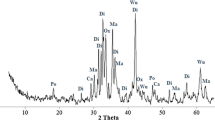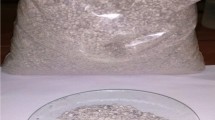Abstract
The basic oxygen furnace steelmaking slag (SL) is employed for CO2 mineralization. Response surface methodology and the central composite design were employed in determining the optimal condition. The optimization goal in this paper has been set for maximum CO2 capturing. It was found that the reaction temperature and CO2 pressure and their combination were significant. A quadratic model was developed for process optimization and statistical experimental designs. The CO2 capture capacity could reach 126 g CO2/kg SL at optimal condition. The increased reaction temperature will lead to an obvious decrease of CaCO3 and increase of MgCO3. If deployed, this optimized indirect CO2 mineral sequestration process could permanently capture 252,000 tons of CO2 per annum based upon current 2 million tons of SL productivity per annum.





Similar content being viewed by others
Abbreviations
- \( a \) :
-
Benedict–Webb–Rubin coefficient (−)
- \( a^{*} \) :
-
Benedict–Webb–Rubin coefficient (−)
- \( A_{0} \) :
-
Benedict–Webb–Rubin coefficient (−)
- \( b \) :
-
Benedict–Webb–Rubin coefficient (−)
- \( B_{0} \) :
-
Benedict–Webb–Rubin coefficient (−)
- \( c \) :
-
Benedict–Webb–Rubin coefficient (−)
- \( C_{0} \) :
-
Benedict–Webb–Rubin coefficient (−)
- \( d_{0} \) :
-
Intercept coefficient (−)
- \( d_{i} \) :
-
Linear coefficient (−)
- \( d_{ii} \) :
-
Quadratic coefficient (−)
- \( f \) :
-
CO2 fugacity (Mpa)
- \( P \) :
-
Pressure (Mpa)
- \( R \) :
-
Pressure gases constant (0.00831 kJ mol−1 K−1)
- \( T \) :
-
Temperature (K)
- \( V_{{{\text{CO}}_{ 2} }} \) :
-
CO2 volume (m−3)
- \( X_{i} \) :
-
Independent variables (−)
- \( Y \) :
-
Predicted response (%)
- \( z \) :
-
Compressed factor (−)
- ANOVA:
-
Analysis of variance
- CCD:
-
Central composite design
- RSM:
-
Response surface methodology
- \( \phi \) :
-
Fugacity coefficient (−)
- \( \alpha \) :
-
Benedict–Webb–Rubin coefficient (−)
- \( \alpha^{*} \) :
-
Benedict–Webb–Rubin coefficient (−)
- \( \rho \) :
-
Fluid density (mol m−3)
- \( \gamma \) :
-
Benedict–Webb–Rubin coefficient (−)
References
Bao WJ, Li HQ, Zhang Y (2010) Selective leaching of steelmaking slag for indirect CO2 mineral sequestration. Ind Eng Chem Res 49:2055–2063
Belmabkhout Y, Guillerm V, Eddaoudi M (2016) Low concentration CO2 capture using physical adsorbents: Are metal-organic frameworks becoming the new benchmark materials? Chem Eng J 296:386–397
Bhatelia T, Li CE, Sun Y, Hazewinkel P, Burke N, Sage V (2014) Chain length dependent olefin re-adsorption model for Fischer–Tropsch synthesis over Co–Al2O3 catalyst. Fuel Process Technol 125:277–289
Biskupski A, Borowik M (1996) Production of magnesium carbonate from dolomite by bicarbonate method with sodium compounds circulation. Przem Chem 75:59–62
Chaudhary N, Balomajumder C (2014) Optimization study of adsorption parameters for removal of phenol on aluminum impregnated fly ash using response surface methodology. J Taiwan Inst Chem E 45:852–859
Chiang YW, Santos RM, Elsen J, Meesschaert B, Martens JA, Van Gerven T (2014) Towards zero-waste mineral carbon sequestration via two-way valorization of ironmaking slag. Chem Eng J 249:260–269
Ectors D, Neubauer J, Goetz-Neunhoeffer F (2013) The hydration of synthetic brownmillerite in presence of low Ca-sulfate content and calcite monitored by quantitative in situ-XRD and heat flow calorimetry. Cem Concr Res 54:61–68
Fried R, Mastai Y (2012) The effect of sulfated polysaccharides on the crystallization of calcite superstructures. J Cryst Growth 338:147–151
Halder G, Dhawane S, Barai PK, Das A (2015) Optimizing chromium(VI) adsorption onto superheated steam activated granular carbon through response surface methodology and artificial neural network. Environ Prog Sustain Energy 34:638–647
Hao R, Al-Tabbaa A (2014) A CCS mineralization process: investigation of the production of magnesium carbonates from magnesium chloride solution. Energy Proc 63:8017–8025
Haszeldine RS (2009) Carbon capture and storage: How green can black be? Science 325:1647–1652
He LL, Yu DX, Lv WZ, Wu JQ, Xu MH (2013) A novel method for CO2 sequestration via indirect carbonation of coal fly ash. Ind Eng Chem Res 52:15138–15145
Hosseini T, Selomulya C, Haque N, Zhang L (2014) Indirect carbonation of victorian brown coal fly ash for CO2 sequestration: multiple-cycle leaching-carbonation and magnesium leaching kinetic modeling. Energ Fuel 28:6481–6493
Hosseini T, Selomulya C, Haque N, Zhang L (2016) Investigating the effect of Mg2+/Ca2+ molar ratio on the carbonate speciation during the mild mineral carbonation process at atmospheric pressure. Energ fuel. doi:10.1021/acs.energyfuels.5b01609
Hu QF (2004) Production and application of magnesium related compounds, vol 2. Chemical Industrial Press, Bei**g
Independent Statistic and Analysis US Energy Information Administration (2016) The CO2 emission from power generation. https://www.eia.gov/tools/faqs/faq.cfm?id=74&t=11
Koen De Crom YWC, Van Gerven Tom, Santos Rafael M (2015) Purification of slag-derived leachate and selective carbonation for high-quality precipitated calcium carbonate synthesis. Chem Eng Res Des 104:180–190
Koga N, Tsuru K, Takahashi I, Ishikawaa K (2015) Effects of humidity on calcite block fabrication using calcium hydroxide compact. Ceram Int 41:9482–9487
Konopacka-Lyskawa D, Koscielska B, Karczewski J (2015) Effect of some organic solvent-water mixtures composition on precipitated calcium carbonate in carbonation process. J Cryst Growth 418:25–31
Kornprobst T, Plank J (2013) Synthesis and properties of magnesium carbonate xerogels and aerogels. J Non-Cryst Solids 361:100–105
Li G, **ao P, Xu D, Webley PA (2011a) Dual mode roll-up effect in multicomponent non-isothermal adsorption processes with multilayered bed packing. Chem Eng Sci 66:1825–1834
Li JR, Ma YG, McCarthy MC, Sculley J, Yu JM, Jeong HK, Balbuena PB, Zhou HC (2011b) Carbon dioxide capture-related gas adsorption and separation in metal-organic frameworks. Coord Chem Rev 255:1791–1823
Montes-Hernandez G, Perez-Lopez R, Renard F, Nieto JM, Charlet L (2009) Mineral sequestration of CO2 by aqueous carbonation of coal combustion fly-ash. J Hazard Mater 161:1347–1354
Morgan B, Wilson SA, Madsen IC, Gozukara YM, Habsuda J (2015) Increased thermal stability of nesquehonite (MgCO3 center dot 3H(2)O) in the presence of humidity and CO2: implications for low-temperature CO2 storage. Int J Greenh Gas Control 39:366–376
National Statistic Bureau Of China (2009) The annual steel productivity reports 2009, Bei**g, China
Nduagu E, Bjorklof T, Fagerlund J, Warna J, Geerlings H, Zevenhoven R (2012) Production of magnesium hydroxide from magnesium silicate for the purpose of CO2 mineralisation—part 1: application to Finnish serpentinite. Miner Eng 30:75–86
Olajire AA (2013) A review of mineral carbonation technology in sequestration of CO2. J Petrol Sci Eng 109:364–392
Oliver TK, Dlugogorski BZ, Kennedy EM (2014) Biologically enhanced degassing and precipitation of magnesium carbonates derived from bicarbonate solutions. Miner Eng 61:113–120
Prieto-Taboada N, Larranaga A, Gomez-Laserna O, Martinez-Arkarazo I, Olazabal MA, Madariaga JM (2015) The relevance of the combination of XRD and Raman spectroscopy for the characterization of the CaSO4–H2O system compounds. Microchem J 122:102–109
Shakerian F, Kim KH, Szulejko JE, Park JW (2015) A comparative review between amines and ammonia as sorptive media for post-combustion CO2 capture. Appl Energ 148:10–22
Sun Y, Webley PA (2011) Preparation of activated carbons with large specific surface areas from biomass corncob and their adsorption equilibrium for methane, carbon dioxide, nitrogen, and hydrogen. Ind Eng Chem Res 50:9286–9294
Sun Y, Chen HZ, **ao X, Li ZH (2006) Fractionation approaches for high value conversion of lignin: a review. J China Pap Pulp Ind 26:58–61
Sun Y, Zhang JP, Yang G, Li M, Li ZH (2007a) Kinetic modeling of diluite acid hydrolysis of corn stover. Chem Eng 35:49–52
Sun Y, Zhang JP, Yang G, Li ZH (2007b) An improved process for preparing activated carbon with large specific surface area from corncob. Chem Biochem Eng Q 21:169–174
Sun Y, Zhang JP, Yang G, Li ZH (2007c) Preparation of activated carbon with large specific surface area from reed black liquor. Environ Technol 28:491–497
Sun Y, Zhang JP, Yang G, Li ZH (2007d) Production of activated carbon by H3PO4 activation treatment of corncob and its performance in removing nitrobenzene from water. Environ Prog Sustain Energy 35:309–316
Sun Y, Wei J, Wang YS, Yang G, Zhang JP (2010) Production of activated carbon by K2CO3 activation treatment of cornstalk lignin and its performance in removing phenol and subsequent bioregeneration. Environ Technol 31:53–61
Sun Y, Yao MS, Zhang JP, Yang G (2011) Indirect CO2 mineral sequestration by steelmaking slag with NH4Cl as leaching solution. Chem Eng J 173:437–445
Sun Y, Zhang JP, Zhang L (2016a) Optimization study of NH4Cl selective leaching parameters of basic oxygen furnace slag using response surface methodology. Environ Prog Sustain Energy 35:1387–1394
Sun Y, Wei J, Zhang JP, Yang G (2016b) Optimization using response surface methodology and kinetic study of Fischer–Tropsch synthesis using SiO2 supported bimetallic Co–Ni catalyst. J Nat Gas Sci Eng 28:173–183
Teir S, Eloneva S, Fogelholm CJ, Zevenhoven R (2007) Dissolution of steelmaking slags in acetic acid for precipitated calcium carbonate production. Energy 32:528–539
Wang K, Han DT, Zhao PF, Hu XM, Yin ZG, Wu D (2015) Role of MgxCa1-xCO3 on the physical-chemical properties and cyclic CO2 capture performance of dolomite by two-step calcination. Thermochim Acta 614:199–206
Yuan G, Chen XF, Li X, Liang QM, Miao GH, Yuan B (2015) The synthesis of calcium carbonate microparticles with multiple morphologies through self-assembly method. Powder Technol 284:253–256
Zevenhoven R, Fagerlund J, Wiklund A, Nduagu E, Forsman AM, Falt M, Mattila HP (1999) CO2 emissions mitigation in Finland by carbonation of silicate minerals and industrial wastes. Int Flame Res Found 1:15
Zhu LX, Yue T, Gao SY, Hu MC, **a SP (2003) Study on the sythesis, FTIR and Raman spectra of A(2)Ca[B4O5(OH)(4)](2)center dot 8H(2)O (A = Rb, Cs). Spectrosc Spect Anal 23:730–733
Acknowledgments
The in-kind contribution from Anpeng High-Tech Alkaline Production Co., Ltd., is highly appreciated. Authors would also like to express appreciation for Professor Yoshihiko Ninomiya at Chubu University of Japan for the reference material analysis by XRF and XRD. The critical comments from three anonymous reviewers in significantly improving the quality of this paper are highly appreciated.
Author information
Authors and Affiliations
Corresponding author
Rights and permissions
About this article
Cite this article
Sun, Y., Yang, G., Li, K. et al. CO2 mineralization using basic oxygen furnace slag: process optimization by response surface methodology. Environ Earth Sci 75, 1335 (2016). https://doi.org/10.1007/s12665-016-6147-7
Received:
Accepted:
Published:
DOI: https://doi.org/10.1007/s12665-016-6147-7




